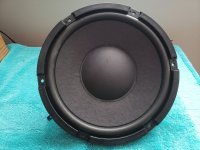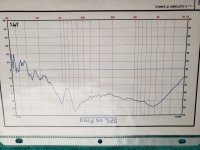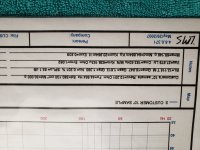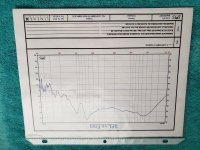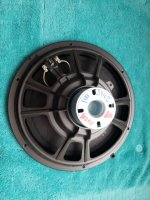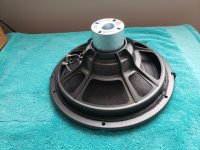I am looking to design some subwoofers that match in style my Duntech Crown Prince speakers. I am looking for true Infra sub sub's. something that will cover the 16hz to 40hz range at the very most. I have a pile of some very interesting drivers i want to use. More details on those later...but...When designing an ELF type system. sealed box, EQ'd response. How do you size the cabinet? does it matter over such a narrow range and if you are applying EQ?
the drivers I have are 10" drivers designed for open air use and have a high-ish Fs. again more details later. but...lets talk about the cabinet theory for now. I want to use 6 drivers per column per side. My Duntechs are nearly 7' tall and narrow so i want to match the look. maybe 12-14" wide at the face. 7' tall and maybe 12-14" deep and I am wondering if i should use one large open column or divide it into equal spaces for each driver. How do you calculate such a box??
the drivers I have are 10" drivers designed for open air use and have a high-ish Fs. again more details later. but...lets talk about the cabinet theory for now. I want to use 6 drivers per column per side. My Duntechs are nearly 7' tall and narrow so i want to match the look. maybe 12-14" wide at the face. 7' tall and maybe 12-14" deep and I am wondering if i should use one large open column or divide it into equal spaces for each driver. How do you calculate such a box??
This is driver choice dependent, so suggest you read Rod's articles re ELF/LRT systems.
http://sound-au.com/project48.htm
http://sound-au.com/project71.htm
Normally just one long column, though with 'open air' specs my SWAG is that you won't be able to do a compact ELF/LRT.
http://sound-au.com/project48.htm
http://sound-au.com/project71.htm
Normally just one long column, though with 'open air' specs my SWAG is that you won't be able to do a compact ELF/LRT.
Make sure your drivers have low enough Qts, so you can get Qtc=0.7 in an acceptable (lowish) volume of the box. Any on-line sealed box calculator (or WinISD, VituixCAD, or similar) can do the calculation...When designing an ELF type system. sealed box, EQ'd response. How do you size the cabinet?
IIRC the idea behind ELF was to use a small box to push up Fb, and the operate the sub completely BELOW Fb. Using a very small box also forces the air compliance to dominate over the suspension compliance, but unfortunately that is different on the in-stroke and out-stroke as one is compressing the air in the box and the other rarefying it. In the old days when driver compliance was very non-linear, that was still better than relying on the driver's own suspension, but these days not so much if the driver is decent. Using a small box such that Fb > 100Hz puts the desired region of operation below the impedance peak where the impedance is returning towards Re at very low frequencies and phase angle is returning towards zero degrees. These properties are nice from the amplifier's point of view. The higher is the Q in the box, the narrower is the impedance peak and the more quickly you get back down the impedance hump. On the other hand, the higher you push Fb the more power will be required at some frequency far below it. I would caution you to take a careful look at how much power is required at low frequencies (this is a sub after all). Things are getting very inefficient down there. Bag End used a very large driver and a very high powered amplifier. You can easily need over 1kW PER DRIVER in that situation. Unless you can take advantage of lots of paralleling of drivers, you may need multiple high power channels to really make the drivers do their thing at VLF unless you get a lot of room gain. The ELF system was being used in very large halls, so room gain was minimal and the pro environment did not place any practical limit on the power input.
These days I would prefer using a large box and a very linear, high displacement driver. For example I am in the process of building a sub that uses two B&C 21DS115 in about a 12 cuft sealed box. These are extremely low distortion 21" pro audio drivers with low Qts, and I will need to use a Linkwitz-Transform to shape the low end as needed. But this also gives me the ability to tune the sub to the room gain.
So I guess to answer your question about box size, shoot for whatever size box gives you an Fb of 100-120Hz and the operate the drivers below 60-70Hz with the necessary correction circuitry.
These days I would prefer using a large box and a very linear, high displacement driver. For example I am in the process of building a sub that uses two B&C 21DS115 in about a 12 cuft sealed box. These are extremely low distortion 21" pro audio drivers with low Qts, and I will need to use a Linkwitz-Transform to shape the low end as needed. But this also gives me the ability to tune the sub to the room gain.
So I guess to answer your question about box size, shoot for whatever size box gives you an Fb of 100-120Hz and the operate the drivers below 60-70Hz with the necessary correction circuitry.
Thanks for coherent explanation of the ELF theory. Gotta admit, for all I've been irritated by subs that have their resonance inside their intended passband, never occurred to me to play below the resonance. Seems obvious with today's tools.two B&C 21DS115 in about a 12 cuft sealed box.
But for some of today's brutish, heavy, strong-cone, high power handling capacity drivers, it is must be really hard to enclose them small enough to get the resonance north of the passband. Any guesses at size of a box to do it? Or fill the little box with some bricks?
What you'd get using the same lumber to make an open baffle would give better results as with a 12 cuft box and might not be more intrusive in your decor. There is no generic model for performance of an open baffle in your real-world room, esp given what you lump together under the misleading term "room gain" correction. The elementary phase cancellation model is frankly too elementary (even with all the geometry explicated, no accounting for phases bouncing off your walls and floor and scrambling). For sure, in almost every respect, those fine drivers would sound better in a large open baffle duly EQ'ed.
B.
Last edited:
I remember the good old days with the Bad End Infrasub-18IIRC the idea behind ELF was to use a small box to push up Fb, and the operate the sub completely BELOW Fb. Using a very small box also forces the air compliance to dominate over the suspension compliance, but unfortunately that is different on the in-stroke and out-stroke as one is compressing the air in the box and the other rarefying it. In the old days when driver compliance was very non-linear, that was still better than relying on the driver's own suspension, but these days not so much if the driver is decent. Using a small box such that Fb > 100Hz puts the desired region of operation below the impedance peak where the impedance is returning towards Re at very low frequencies and phase angle is returning towards zero degrees. These properties are nice from the amplifier's point of view. The higher is the Q in the box, the narrower is the impedance peak and the more quickly you get back down the impedance hump. On the other hand, the higher you push Fb the more power will be required at some frequency far below it. I would caution you to take a careful look at how much power is required at low frequencies (this is a sub after all). Things are getting very inefficient down there. Bag End used a very large driver and a very high powered amplifier. You can easily need over 1kW PER DRIVER in that situation. Unless you can take advantage of lots of paralleling of drivers, you may need multiple high power channels to really make the drivers do their thing at VLF unless you get a lot of room gain. The ELF system was being used in very large halls, so room gain was minimal and the pro environment did not place any practical limit on the power input.
These days I would prefer using a large box and a very linear, high displacement driver. For example I am in the process of building a sub that uses two B&C 21DS115 in about a 12 cuft sealed box. These are extremely low distortion 21" pro audio drivers with low Qts, and I will need to use a Linkwitz-Transform to shape the low end as needed. But this also gives me the ability to tune the sub to the room gain.
I'm building the same concept here now although with other drivers and a bit larger volume: dual SBAudience NERO21SW1100D in a 14cuft sealed box. I was tempted to use low tuned ports but could pull myself together. And you gotta love those 21" drivers for their efficiency. I already have two B&C 21SW152 that will also be converted to sealed after finishing the SBAudience project.
I have quite a few of these interesting drivers. these were Subwoofers for the Mark Levinson audio system in Lincolns i believe. I got these from an Audio Society member that used to work for Harmon I think it was, that did the design work on the high end audio systems. These are a 10" Neo driver with a 12ohm Impedance. I was told they wanted to minimize the current draw on the electrical system so they designed an amplifier with plenty of voltage swing and a 12 ohm driver to minimize the current draw from the vehicles electric system. apparently the exec's did not like it when the bass would hit and the lights would dim.
I had a friend of mine at MISCO (Minneapolis Speaker Company) test these and they were quite impressed with the Klippel linearity on these. My Thought was to use 12 of them, 6 per 7' tall column wired for 8ohms (Three in parallel = 4 ohms, then series wired with another Three for 8 ohms), Or possibly depending on what amp i use, wired for 2 ohms per column...
As these will be used for home use. the large amount of cone area, should limit cone excursions under normal listening levels and hopefully reduce distortion. at least in theory was my thinking. Not sure of the specs of these drivers are really suitable, but i figured i would give them a try. just need to figure out how to design a cabinet for them. an ELF type system seemed to make the most sense to match the design athetics of my Duntech Speakers
I had a friend of mine at MISCO (Minneapolis Speaker Company) test these and they were quite impressed with the Klippel linearity on these. My Thought was to use 12 of them, 6 per 7' tall column wired for 8ohms (Three in parallel = 4 ohms, then series wired with another Three for 8 ohms), Or possibly depending on what amp i use, wired for 2 ohms per column...
As these will be used for home use. the large amount of cone area, should limit cone excursions under normal listening levels and hopefully reduce distortion. at least in theory was my thinking. Not sure of the specs of these drivers are really suitable, but i figured i would give them a try. just need to figure out how to design a cabinet for them. an ELF type system seemed to make the most sense to match the design athetics of my Duntech Speakers
Attachments
I was hoping that in a small sealed enclosure and then EQ'd flat, they would work. they were designed for subwoofer duty, but albeit not as low as i want them to go. 12 of them in a room would not have to do much work i would think. I just dont like big flabby sloppy woofers which are all the rage these days. i want fast, clean and articulate infra bass. and...I have more than a dozen of these already and want to do SOMETHING with them.
They will make a fair amount of LF in a small enclosure EQ'd flat, but will require a lot of power to do so.I was hoping that in a small sealed enclosure and then EQ'd flat, they would work. I have more than a dozen of these already and want to do SOMETHING with them.
The EQ in the sim is just for illustration of what is possible.
The impedance is 2 ohms 10 Hz to 40 Hz for 6 drivers in parallel.
80 volts into the 12 drivers (533 watts per driver) would do about 112 dB at 20Hz at 8mm excursion in one cubic foot (28liter) per driver half space. Increasing the cabinet volume to the size of the Duntechs or a bit larger would make little difference in output. Room gain and wall proximity could increase LF considerably.
The 12 drivers should have no problem supporting the four 9" 5.5mm Xmax Dynaudio 24W75 for clean and articulate bass lines.
Did your friend at MISCO give you a copy of the Klippel tests showing the excursion of your drivers?
Art
All of the box calculators i have tried don't like the Qts numbers of these drivers??

Depends on modeler.
Most are looking to calculate at .5 .577 or .707 Qtc
.577 being " flat" driver response or equal ripple
The overall mechanical properties of this driver don't allow
Qtc to be much lower than 1.5
Which is very high, so the modeler is basically saying
it is impossible to get equal ripple response.
So response will never ever be flat.
Being a " special design" driver
it is not even designed to be flat.
To even achieve very very high Q response
at 1.5
The driver needs about 7 cubic feet.
To me this basically smells like a " custom designed"
speaker to achieve a big 50 Hz boost in a car application.
like a lot of typical car subs.
Most 10" mechanically designed to work in a " enclosure"
1 to 2 cubic feet.
This case it seems more designed to be mounted on, or near a 'rear deck'
where there is no enclosure. The enclosure is the trunk or car cabin itself.
And average trunk 5 to 9 cubic feet.
So no this speaker does not like a tiny box.
and definitely wont like being in a tiny box then over Equalized.
more suited for a car trunk with no enclosure.
providing 5 to 9 cubic feet of trunk space.
Otherwise in HiFi might make a good woofer
not sub woofer in open baffle.
either way its designed to be a subwoofer
that makes a dominant 50 Hz " knock"
or not a flat response. And to even achieve
a very un flat peak. needs at minimum 7 cubic feet
Just an anecdotal observation about the subjective effect of an extended deep-bass sub response in general. I once owned a 15-inch acoustic-suspension subwoofer, which produced an interesting listening sensation which I hadn't expected. It provided a definite feeling of increased ambience to many orchestral performances. To be clear, this wasn't a sensation of added orchestral bass, but a sensation of much greater ambient space. Perhaps paradoxically, my listening room felt less 'pressurized' to my ears, rather than feeling more pressurized, as is often provided by adding a subwoofer. I suspect that a sensation of greater acoustic pressure has more to due with mains-to-sub mid-bass integration.
I presume that the aural sensation of a reduced room pressure was due to a more accurate reproduction of the recording venue's acoustic ambience, but I'm uncertain. In the end, I didn't keep that 15"sub because I couldn't get it to satisfactorily integrate with the satellite speakers which I had at that time. I eventually settled on a 12-inch vented-sub that did integrate well. It didn't, however, provide that same feeling of increased ambience which the 15" A.S. sub did. I've been using full-range speakers for decades now, but am occasionally tempted to experiment with integrating a true deep bass sub in pursuit of that sensation of increased venue ambience. As we all know, those are the most expensive subs. While I've never auditioned it, BAG END's ELF subwoofer approach seems like it could be the most cost effective deep-bass solution, due the relatively very small enclosure needed.
I presume that the aural sensation of a reduced room pressure was due to a more accurate reproduction of the recording venue's acoustic ambience, but I'm uncertain. In the end, I didn't keep that 15"sub because I couldn't get it to satisfactorily integrate with the satellite speakers which I had at that time. I eventually settled on a 12-inch vented-sub that did integrate well. It didn't, however, provide that same feeling of increased ambience which the 15" A.S. sub did. I've been using full-range speakers for decades now, but am occasionally tempted to experiment with integrating a true deep bass sub in pursuit of that sensation of increased venue ambience. As we all know, those are the most expensive subs. While I've never auditioned it, BAG END's ELF subwoofer approach seems like it could be the most cost effective deep-bass solution, due the relatively very small enclosure needed.
Getting back to the thread question. In reading the ELF whitepaper which I posted, it indicates that the box size does matter. It should be sized to provide an acoustic suspension resonance frequency which is at, or just above the signal pass-band. Which, then, necessitates that the subwoofer driver fs support enabling that high resonance frequency. The design example discussed in the whitepaper has a box/driver resonance of about 90Hz. Which is at the upper limit of the sub's intended signal band. This is done to obtain the predictable 2nd order high-pass acoustic response roll-off which A.S. systems provide below resonance. The resulting relatively small ELF box is only an incidental benefit. You don't, however, want the box/driver system resonance to be much higher than the signal's pass-band either. Although the box then becomes even smaller, the sub's power amplifier is more greatly tasked than is necessary.
Last edited:
Most box modelers attempt to give you the box volume for a Q = 0.707 (maximually flat). That is impossible with this driver because the driver's own Qts is higher than this value and the only possibility when you put a driver in a box is for Q>Qts.All of the box calculators i have tried don't like the Qts numbers of these drivers??
- Home
- Loudspeakers
- Subwoofers
- When designing a ELF type subwoofer, does the cabinet size matter?
